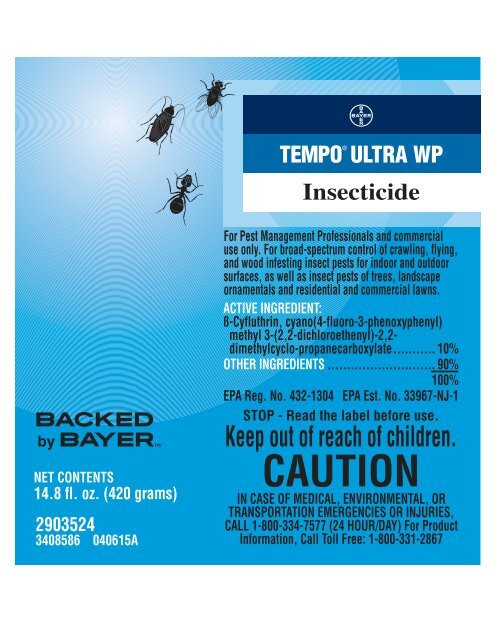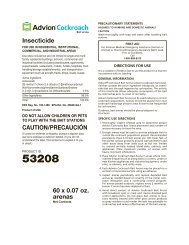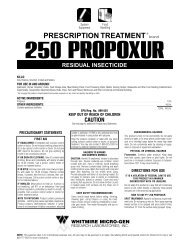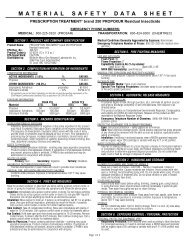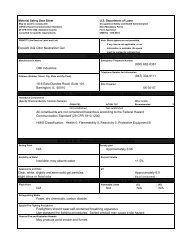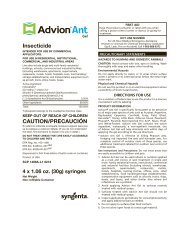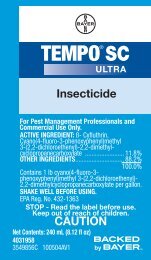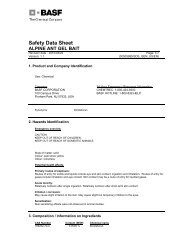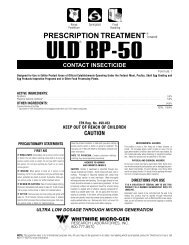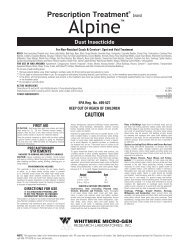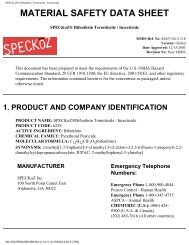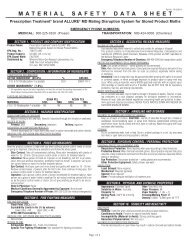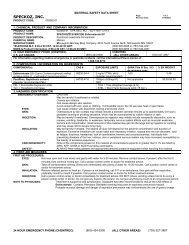Create successful ePaper yourself
Turn your PDF publications into a flip-book with our unique Google optimized e-Paper software.
Insecticide<br />
NET CONTENTS<br />
14.8 fl. oz. (420 grams)<br />
2903524<br />
3408586 040615A<br />
For <strong>Pest</strong> <strong>Management</strong> Professionals and commercial<br />
use only. For broad-spectrum control of crawling, flying,<br />
and wood infesting insect pests for indoor and outdoor<br />
surfaces, as well as insect pests of trees, landscape<br />
ornamentals and residential and commercial lawns.<br />
ACTIVE INGREDIENT:<br />
ß-Cyfluthrin, cyano(4-fluoro-3-phenoxyphenyl)<br />
methyl 3-(2,2-dichloroethenyl)-2,2-<br />
dimethylcyclo-propanecarboxylate........... 10%<br />
OTHER INGREDIENTS ............................ 90%<br />
100%<br />
EPA Reg. No. 432-1304 EPA Est. No. 33967-NJ-1<br />
STOP - Read the label before use.<br />
Keep out of reach of children.<br />
<strong>CAUTION</strong><br />
IN CASE OF MEDICAL, ENVIRONMENTAL, OR<br />
TRANSPORTATION EMERGENCIES OR INJURIES,<br />
CALL 1-800-334-7577 (24 HOUR/DAY) For Product<br />
Information, Call Toll Free: 1-800-331-2867
If on skin<br />
If inhaled<br />
If in eyes<br />
If<br />
swallowed<br />
FIRST AID<br />
• Take off contaminated clothing.<br />
•Rinse skin immediately with plenty of water for 15 to 20 minutes.<br />
• Call a poison control center or doctor for treatment advice.<br />
• Move person to fresh air.<br />
• If person is not breathing, call 911 or an ambulance, then give<br />
artificial respiration, preferably mouth-to-mouth if possible.<br />
• Call a poison control center or doctor for further treatment<br />
advice.<br />
• Hold eye open and rinse slowly and gently with water for 15 to<br />
20 minutes. Remove contact lenses, if present, after the first 5<br />
minutes, then continue rinsing eye.<br />
• Call a poison control center or doctor for treatment advice.<br />
• Call a poison control center or doctor immediately for<br />
treatment advice.<br />
• Have person sip a glass of water if able to swallow.<br />
• Do not induce vomiting unless told to do so by a poison control<br />
center or doctor.<br />
• Do not give anything to an unconscious person.<br />
Have the product container or label with you when calling a poison control<br />
center or doctor or going for treatment. You may also contact 1-800-334-<br />
7577 for emergency medical treatment.<br />
Note To Physician: No specific antidote is available. Treat the patient<br />
symptomatically.<br />
PRE<strong>CAUTION</strong>ARY STATEMENTS<br />
HAZARDS TO HUMANS AND DOMESTIC ANIMALS<br />
<strong>CAUTION</strong>: Causes moderate eye irritation. Harmful if swallowed, inhaled or<br />
absorbed through the skin. Do not get in eyes, on skin, or on clothing. Avoid<br />
breathing dust or spray mist. Wash thoroughly with soap and warm water after<br />
handling. Remove contaminated clothing and wash before reuse.<br />
2
Wear safety glasses, goggles, or face shield when handling the undiluted material<br />
and wear a respirator when making general surface overhead treatments indoors.<br />
Do not allow children or pets to enter treated areas until surfaces are dry.<br />
ENVIRONMENTAL HAZARDS<br />
This pesticide is toxic to fish. Remove from premises or tightly cover fish tanks<br />
and disconnect aerators when applying indoors where such containers are<br />
present. Do not apply directly to water, or to areas where surface water is present<br />
or to intertidal areas below the mean high water mark. Drift and runoff from<br />
treated areas may be hazardous to aquatic organisms in neighboring areas. Do<br />
not contaminate water when disposing of equipment washwaters. Apply this<br />
product only as specified on this label.<br />
This pesticide is highly toxic to bees exposed to direct treatment or residues on<br />
crops or weeds. Do not apply TEMPO ® ULTRA WP Insecticide or allow it to drift<br />
onto crops or weeds on which bees are actively foraging. Additional information<br />
may be obtained by consulting your Cooperative Extension Service.<br />
PRO FACTS<br />
• Quick Knockdown & Residual Control • Low Odor<br />
• Non-staining • No phytotoxicity on a wide range of ornamentals<br />
TEMPO ULTRA WP<br />
CONTROLS<br />
WHERE TO<br />
APPLY<br />
• Wettable powder containing 10% beta-cyfluthrin<br />
• Indoor <strong>Pest</strong>s<br />
- General Household <strong>Pest</strong>s<br />
- Pantry and Stored Product <strong>Pest</strong>s<br />
- Food Processing <strong>Pest</strong>s<br />
• Outdoor/ Perimeter <strong>Pest</strong>s<br />
• Wood-Infesting <strong>Pest</strong>s<br />
• Turf and Ornamental <strong>Pest</strong>s<br />
For list of specific insects, see inside.<br />
• Apply where pests have been seen or found, or can find shelter.<br />
• In and around buildings and structures<br />
• On residential, commercial and recreational areas of turf<br />
• On ornamentals in landscapes and interior plantscapes<br />
(Continued)<br />
3
PRO FACTS (Continued)<br />
COVERAGE • Makes up to 42 gallons of finished spray solution for<br />
indoors. (420 g size)<br />
• Treats up to 84,000 square feet. outdoors. (420 g size)<br />
MIXING<br />
• Mix the appropriate amount of TEMPO ULTRA WP with<br />
INFORMATION water.<br />
• May tank mix with other pesticides currently registered<br />
for similar uses, unless specifically prohibited.<br />
HOW TO APPLY •General surface spot, mist, or crack & crevice application.<br />
• Broadcast application to turf and foliar application to<br />
ornamentals.<br />
RE-APPLY • Every 7 to 10 days, if needed.<br />
• For turf, reapply if needed, but not more than 6 times per year.<br />
RE-ENTRY • Avoid contact with treated surfaces until dry.<br />
•People and pets may re-enter after the treated area is dry.<br />
QUESTIONS For questions or comments, call toll-free 1-800-331-2867<br />
www.BackedByBayer.com<br />
DIRECTIONS FOR USE<br />
It is a violation of Federal law to use this product in a manner inconsistent with<br />
its labeling.<br />
IMPORTANT: Read entire label and Conditions of Sale before using this product.<br />
Do not formulate this product into other end-use products.<br />
STRUCTURAL PESTS<br />
FOR RESIDUAL PEST CONTROL IN AND AROUND BUILDINGS, STRUCTURES,<br />
FOOD/FEED HANDLING ESTABLISHMENTS AND MODES OF TRANSPORT<br />
Use TEMPO ULTRA WP as a general surface, spot, mist, or crack and crevice<br />
treatment in and around buildings and structures. This includes schools, factories,<br />
stores, warehouses, hospitals, food processing facilities, and modes of transport.<br />
For a list of common facilities where this product may be used, see Appendix.<br />
4
INDOOR PESTS<br />
General Household <strong>Pest</strong>s<br />
Crawling <strong>Pest</strong>s<br />
Ants (except Pharaoh)<br />
Bedbugs<br />
Carpet beetles<br />
Centipedes<br />
Clothes moths<br />
Cluster flies<br />
Pantry & Stored Product <strong>Pest</strong>s<br />
Beetles<br />
(exposed adults &<br />
immature stages)<br />
Cadelle<br />
Cigarette<br />
Confused flour<br />
Dermestid<br />
Drugstore<br />
Food Processing <strong>Pest</strong>s<br />
Fruit flies<br />
Phorid flies<br />
Sciarid flies<br />
WHERE TO<br />
APPLY<br />
USE RATE<br />
Cockroaches<br />
Crickets<br />
Darkling beetles<br />
Earwigs<br />
Firebrats<br />
Millipedes<br />
Granary weevil<br />
Hide<br />
Larder<br />
Leather<br />
Lesser grain borer<br />
Lesser mealworm<br />
Merchant grain<br />
Pillbugs<br />
Silverfish<br />
Sowbugs<br />
Spiders<br />
Mealworm<br />
Red flour<br />
Rice weevil<br />
Sawtoothed<br />
grain<br />
Warehouse<br />
Flying <strong>Pest</strong>s<br />
Flies<br />
Gnats<br />
Hornets<br />
Midges<br />
Moths<br />
Wasps<br />
Yellow jackets<br />
Moths<br />
Indian meal<br />
Mediterranean<br />
flour<br />
Also includes:<br />
General Household <strong>Pest</strong>s<br />
Pantry & Stored Product <strong>Pest</strong>s<br />
Apply where pests have been seen or found, or can find shelter.<br />
Use a general surface, spot, mist, or crack and crevice application.<br />
0.025% -- 10 g (2 scoops)/gallon water<br />
0.05% -- 20 g (4 scoops)/gallon water<br />
•Use high rate for severe infestations, faster knockdown, and<br />
longer residual.<br />
•Always use the high rate for bees, wasps, yellow jackets and hornets.<br />
(Continued)<br />
5
INDOOR PESTS<br />
HOW TO APPLY (Also see APPLICATION FOR INDOOR PESTS)<br />
•Remove or tightly cover fish tanks and disconnect aerators during application.<br />
•Remove pets during application and until treated surfaces are completely dry.<br />
•Avoid contact with treated surfaces until dry.<br />
•Wear safety glasses, goggles, or face shield and a dust/mist respirator when<br />
treating overhead areas.<br />
General Surface Applications<br />
•Use a low-pressure system (do not exceed 50 psi at nozzle tip), with a fan-type<br />
nozzle to apply the dilution uniformly.<br />
•In the home, all food processing surfaces and utensils should be covered or<br />
thoroughly washed following treatment. Cover exposed food or remove from area<br />
being treated.<br />
Spot, Mist, or Crack and Crevice Applications<br />
•Apply directly into voids, cracks and crevices using spray or foam equipment.<br />
•Spray: Use a low-pressure system (do not exceed 50 psi at nozzle tip), with a<br />
pinpoint or variable pattern nozzle or applicator equipment that delivers low volume<br />
treatments, such as the Micro-Injector ® or Actisol ® .<br />
•Foam: Use appropriate foam generating equipment to supply a sufficient volume of<br />
foam. Mix the dilution with manufacturer's recommended volume of foaming<br />
agent.<br />
WHEN TO •When pests are seen or found<br />
APPLY • Re-apply every 7 to 10 days if needed.<br />
MIXING •Add product when filling spray tank with water; shake or agitate<br />
INFORMATION mixture.<br />
• Diluted spray mixture can be stored overnight. Agitate before using.<br />
Can be tank mixed with other pesticides currently registered for similar<br />
uses. To be sure of physical compatibility, first prepare a sample in a<br />
small jar using the proper proportions of water and products.<br />
Follow the most restrictive of labeling directions and precautions. Do<br />
not exceed label rates.<br />
6 (Continued)
INDOOR PESTS (Continued)<br />
RESTRICTIONS • Do not treat entire area of floor or floor coverings.<br />
• Do not apply where electrical short circuits can occur. Use a dust or<br />
dry bait in these areas.<br />
• Do not apply in occupied hospital and/or nursing home rooms.<br />
Occupants may return when surfaces have dried.<br />
• Do not apply in occupied classrooms.<br />
• Do not apply to furniture or upholstery where prolonged contact by<br />
humans will occur.<br />
• Do not apply as a space spray<br />
ADDITIONAL DIRECTIONS FOR FOOD AND FEED HANDLING ESTABLISHMENTS<br />
WHERE TO Applications may be made to both food/feed and non-food areas of<br />
APPLY food and feed handling establishments.<br />
Food/feed handling establishments are defined as places other than<br />
private residences in which exposed food/feed is held, processed,<br />
prepared, or served.<br />
Includes areas for:<br />
• receiving, storing and packing (canning, bottling, wrapping, boxing)<br />
food<br />
• preparing food<br />
• edible waste storage<br />
• enclosed processing systems (mills, dairies, edible oils, syrups) of<br />
food.<br />
Serving areas where food is exposed and the facility is in operation<br />
are also considered food areas.<br />
USE RATE • Apply as a general surface spot, mist, or crack & crevice application.<br />
0.025% -- 10 g (2 scoops)/gallon water<br />
0.05% -- 20 g (4 scoops)/gallon water<br />
• Use high rate for severe infestations, faster knockdown, and longer<br />
residual.<br />
7<br />
(Continued)
ADDITIONAL DIRECTIONS FOR FOOD AND FEED HANDLING ESTABLISHMENTS (Cont)<br />
HOW TO General Surface Applications<br />
APPLY Cover or remove all food processing and handling equipment before<br />
treatment.<br />
(Also see After applying where food is commercially prepared or processed,<br />
INDOOR wash all handling and processing equipment, benches, shelving,<br />
PESTS) and other surfaces which food will contact. Rinse thoroughly with clean,<br />
fresh water.<br />
Do not apply to surfaces in food handling areas when facility is in use<br />
or when foods are exposed.<br />
Do not apply directly to food.<br />
Spot or Crack & Crevice Applications<br />
Spot or crack and crevice application is permitted while facility is in use.<br />
Cover or remove food from area being treated.<br />
Do not apply directly to food or food handling surfaces.<br />
APPLICATION FOR INDOOR PESTS<br />
GENERAL •Use a coarse, low-pressure spray.<br />
HOUSEHOLD •Treat entry points such as around water pipes, doors, windows,<br />
PESTS and eaves. Treat areas where pests normally feed or hide such as<br />
Cockroaches, baseboards, corners, around water pipes, under refrigerators,<br />
Crickets, cabinets, sinks, and stoves, being sure to spray cracks & crevices.<br />
Silverfish, Spot treat floor or rugs beneath furniture, in closets, and storage<br />
Spiders, areas, but do not apply to entire floor area.<br />
and others • Do not use as a “space spray.”<br />
• IGR Note: This product can be tank mixed with an insect growth<br />
regulator (IGR) for extended cockroach control.<br />
ANTS • Apply to ant trails on walls, tile, baseboards, around pipes, under<br />
cabinets, and other places where ants are active.<br />
•Treat entry points such as windows and doors and the outdoor<br />
perimeter.<br />
8<br />
(Continued)
APPLICATION FOR INDOOR PESTS (Continued)<br />
ANTS (Continued) •For best results, treat nests when possible.<br />
PANTRY AND •For best results, clean area before treating. Remove and<br />
STORED<br />
destroy infested food. Discard food accidentally<br />
PRODUCT PESTS contaminated with spray.<br />
•For cupboards, shelving, or food storage areas: Remove<br />
utensils, exposed food, shelf paper, and other items before<br />
spraying. When dried, cover shelves with clean paper<br />
before replacing items.<br />
COMMERCIAL •Commercial storage or transportation: Clean and treat<br />
STORED<br />
warehouses, production facilities, storage areas, rail cars,<br />
PRODUCT PESTS truck beds, and other areas where products are stored<br />
before filling with the product.<br />
PESTS IN AIRCRAFT •For use only in aircraft cargo holds<br />
PESTS IN LIVESTOCK •Apply as a general surface and/or a crack and crevice spray.<br />
HOUSING<br />
•For best results, clean facilities before applying and treat<br />
STRUCTURES outdoor perimeter areas.<br />
including poultry •Do not apply indoors where animals other than cattle or<br />
houses & pet horses are present.<br />
kennels<br />
•Do not apply to animal feedstuffs or watering equipment.<br />
FLYING INSECTS •Apply to surfaces where pests collect or rest.<br />
STRUCTURAL PESTS<br />
OUTDOOR/PERIMETER PESTS<br />
Ants<br />
Cluster flies Flies<br />
Bees<br />
Crickets Gnats<br />
Boxelder bugs Elm leaf beetles Ground beetles<br />
Carpenter ants Fire ants Hornets<br />
Centipedes Firebrats Midges<br />
Cockroaches Fleas<br />
Millipedes<br />
9<br />
Moths<br />
Pillbugs<br />
Scorpions<br />
Silverfish<br />
Sowbugs<br />
Spiders<br />
Ticks<br />
Wasps<br />
Yellow jackets<br />
(Continued)
OUTDOOR/PERIMETER PESTS (Continued)<br />
WHERE TO • Apply where pests have been seen or found, or can find shelter.<br />
APPLY • Apply to buildings, porches, patios, garages, fences and other<br />
areas where pests are found.<br />
• To prevent infestation, treat the building foundation, walls, and<br />
around doors, windows, and soffits where pests are active or<br />
may enter or hide; also treat the soil, turf, or other substrates<br />
adjacent to buildings.<br />
USE RATE • 10 to 20 g (2 to 4 scoops)/1,000 square feet See Table 1 for<br />
mixing directions.<br />
• For fire ants and flying pests<br />
0.025% -- 10 g (2 scoops)/gallon water<br />
0.05% -- 20 g (4 scoops)/gallon water<br />
• Always use the high rate for fire ants, bees, wasps, yellow<br />
jackets and hornets.<br />
• Use high rate for severe infestations, faster knockdown, and<br />
longer residual.<br />
HOW TO • Perimeter Treatment: To help prevent infestation of structures,<br />
APPLY treat area adjacent buildings in a band up to 10 feet wide. Also<br />
treat the building foundation to a height of 2 to 3 feet in areas<br />
(Also see where pests are active or can find entrance.<br />
APPLICATIONS • Apply just enough dilution to adequately cover the area without<br />
FOR<br />
excessive dripping or runoff. Volume can vary depending on the<br />
OUTDOOR/ surface type treated. For example, mulch requires more spray<br />
PERIMETER than bare soil. If mulch is heavy, rake it back to expose soil<br />
PESTS) before treating.<br />
• Avoid contact with treated surfaces until dry.<br />
WHEN TO • When pests are seen or found<br />
APPLY • Re-apply every 7 to 10 days if needed.<br />
MIXING • Add product when filling spray tank with water; shake or agitate<br />
INFORMATION mixture.<br />
(Continued)<br />
10
OUTDOOR/PERIMETER PESTS (Continued)<br />
MIXING • Diluted spray mixture can be stored overnight. Agitate before<br />
INFORMATION using.<br />
(Continued) Can be tank mixed with other pesticides currently registered for<br />
similar uses. To be sure of physical compatibility, first prepare a<br />
sample in a small jar using the proper proportions of water and<br />
products. Follow the most restrictive of labeling directions and<br />
precautions. Do not exceed label rates.<br />
Table 1: Mixing Directions for Outdoor/Perimeter Applications<br />
Application Volume:<br />
Gallons/1,000 sq. ft.<br />
2<br />
5<br />
10<br />
Use Rate:<br />
Grams/<br />
1,000 sq. ft.<br />
Scoops* of TEMPO ULTRA WP<br />
Diluted to These Volumes of Finished Spray<br />
3 gal. 10 gal. 15 gal. 25 gal.<br />
10 3 10 15 25<br />
20 6 20 30 50<br />
10 1 4 6 10<br />
20 2 8 12 20<br />
10 -- 2 3 5<br />
20 -- 4 6 10<br />
* 1 level scoop = 5 grams<br />
Formula for Determining the Percent Concentration in the Finished Spray<br />
(Scoops of TEMPO ULTRA WP)<br />
= Percent Concentration<br />
(Gallons of finished spray) x 75.7<br />
APPLICATION FOR OUTDOOR/PERIMETER PESTS<br />
ANTS Locate and treat ant nests, if possible. Follow trails of foraging workers,<br />
check under objects near the structure, and inspect other likely nest<br />
sites. If ants are nesting in the soil, thoroughly drench or inject the nest<br />
(Continued)<br />
11
APPLICATION FOR OUTDOOR/PERIMETER PESTS (Continued)<br />
ANTS and surrounding soil. Treat ant trails around windows and doors,<br />
(Continued) along sidewalks, or other areas where seen. Apply a perimeter<br />
treatment as described above.<br />
BEES, Use Rate: 0.05% concentration<br />
WASPS, Make pin stream applications directly to the nests. To help avoid<br />
YELLOW stings treat nests in the evening when the insects are inside the<br />
JACKETS, nest. For best results, check nests within one or two days to<br />
HORNETS ensure complete kill. Remove and destroy treated nests to prevent<br />
emergence of newly hatched insects, secondary pest problems,<br />
and possible staining from honey. If removal is not possible,<br />
retreat nests if necessary.<br />
BOXELDER Apply directly to boxelder bugs that have congregated around<br />
BUGS doors and windows and similar areas where they may enter<br />
structures. Apply perimeter treatment as described above. For best<br />
results, treat infested trees early in the season. Tree spraying may<br />
require ornamental license – check with your local regulator.<br />
CENTIPEDES, Apply perimeter treatment to reduce the number of insects from<br />
MILLIPEDES, entering the structure. Thoroughly treat mulched areas. Reduce<br />
PILLBUGS, moisture areas from around the structure.<br />
SOWBUGS<br />
FIRE ANTS Use Rate: 0.05% concentration<br />
Thoroughly drench or inject the entire mound. When using injection<br />
treatment, you must treat the bottom of the mound. Apply dilution<br />
or foam using a downward and upward motion of the injector tool.<br />
For complete distribution, inject in several points throughout the<br />
mound.<br />
Treat new mounds as they appear.<br />
Do not use in pastures or areas of food crop production.<br />
FLEAS & Make a perimeter treatment, concentrating on areas where pets rest<br />
TICKS or run. For ticks, treat likely harborage areas like along paths, tall<br />
(Continued)<br />
12
APPLICATION FOR OUTDOOR/PERIMETER PESTS (Continued)<br />
FLEAS & grass and other vegetation. For best results, treat the entire area<br />
TICKS where ticks could be present. Begin treating in the spring. Ticks may<br />
(Continued) be re-introduced from surrounding areas by host animals. Continue<br />
treating until frost to control both larvae and adult ticks.<br />
FLIES Use Rate: 0.025% to 0.05% concentration<br />
Apply low-volume mist or spray to outside surfaces of buildings,<br />
porches, patios, garages, fences, and other areas where flies rest.<br />
CLUSTER FLIES: Treat in late summer or fall, just before flies begin<br />
looking for winter shelter. Spray siding, eaves, around windows and<br />
doors, window screens, and attics. To help reduce infestations, treat<br />
cracks and crevices, attics and other indoor winter hiding places.<br />
Note: Cluster flies may appear during winter warm spells, while<br />
snow is still on the ground.<br />
MOSQUITOES Spray around landscape plants, turf and ground cover, under decks,<br />
around building foundations and other places where mosquitoes<br />
may rest.<br />
SCORPIONS Treat around piles of firewood and other areas where scorpions may<br />
hide. When possible, remove piles of materials that can harbor the<br />
pests. Apply a perimeter treatment.<br />
WOOD-INFESTING PESTS<br />
Beetles<br />
Ambrosia Old house borer<br />
Deathwatch Powderpost<br />
False powderpost<br />
STRUCTURAL PESTS<br />
13<br />
Carpenter ants<br />
Carpenter bees<br />
Termites<br />
Subterranean<br />
Formosan<br />
Drywood<br />
WHERE TO APPLY Apply where pests have been seen or found, or can find shelter.<br />
USE RATE 0.05% -- 20 g (4 scoops)/gallon water<br />
(Continued)
WOOD-INFESTING PESTS (Continued)<br />
HOW TO APPLY • Apply spray or foam as described in application section.<br />
(Also see • Avoid contact with treated surfaces until dry.<br />
Application<br />
section)<br />
WHEN TO APPLY • When pests are seen or found<br />
• Re-apply every 7 to 10 days if needed.<br />
MIXING • Add product when filling spray tank with water; shake or<br />
INFORMATION agitate mixture.<br />
• Diluted spray mixture can be stored overnight. Agitate before<br />
using.<br />
• Can be tank mixed with other pesticides currently registered<br />
for similar uses. To be sure of physical compatibility, first<br />
prepare a sample in a small jar using the proper proportions<br />
of water and products. Follow the most restrictive of labeling<br />
directions and precautions. Do not exceed label rates.<br />
• Foam applications: Mix end-use dilution with manufacturer's<br />
recommended volume of foaming agent for 0.025% to 0.05%<br />
concentration.<br />
CARPENTER<br />
ANTS<br />
APPLICATION FOR WOOD-INFESTING PESTS<br />
In houses and other structures: Apply around doors and windows<br />
and other places where carpenter ants may enter. Spray or foam into<br />
cracks & crevices, or spray, mist or foam through small drilled holes<br />
into voids where ants or nests are present. Use enough spray or foam<br />
to cover the area. Do not exceed 1 gallon of dilution per 1,000 square<br />
feet.<br />
Inside trees, utility poles, fencing and decking materials and similar<br />
structural members: Drill to find the interior infested cavity and inject<br />
dilution or foam using an appropriate treatment tool with a<br />
splashback guard.<br />
14<br />
(Continued)
APPLICATION FOR WOOD-INFESTING PESTS (Continued)<br />
CARPENTER Tunneling in soil: Apply as a soil drench or inject the dilution or foam<br />
ANTS in the soil at intervals of 8 to 12 inches. Use 1 gallon of dilution per<br />
(Continued) 8 square feet. Establish a uniform vertical barrier at the edge of walls,<br />
driveways or other hard surfaces where ants are tunneling beneath<br />
the surfaces.<br />
Protecting firewood from carpenter ants: Treat soil beneath firewood<br />
before stacking at 1 gallon of dilution per 8 square feet.<br />
Do not treat firewood with this product.<br />
CARPENTER In structures: Spray or foam directly into gallery entrance holes.<br />
BEES Leave entrance open for 24 hours to be sure that returning adult bees<br />
are killed. When there is no activity, the hole may be sealed with a<br />
suitable sealant.<br />
WOOD- On surfaces in homes, apartments, and other structures<br />
INFESTING For small areas, brush or spray evenly on wood surfaces.<br />
BEETLES For large or overhead areas, thoroughly cover wood surfaces with a<br />
coarse spray.<br />
Protect surfaces below the treated area from accidental dripping by<br />
covering with disposable plastic sheeting or other material that can<br />
be thrown away after treatment.<br />
In localized areas: Apply dilution or foam to voids and galleries in<br />
damaged wood, in spaces between wooden structural members, and<br />
between the sill plate and foundation. Apply to inaccessible areas by<br />
drilling, and then injecting, spraying, or misting the dilution or foam<br />
into the damaged wood or wall voids.<br />
DRYWOOD This type of application is intended to be a supplemental treatment<br />
AND for control of drywood and above-ground subterranean termites and<br />
ABOVE- other wood-infesting insects.<br />
GROUND In localized areas: Apply dilution or foam to voids and galleries in<br />
SUB- damaged wood, to spaces between wooden structural members, and<br />
TERRANEAN between the sill plate and foundation. Apply to inaccessible areas by<br />
TERMITES drilling, and then injecting, spraying, or misting the dilution or foam<br />
15<br />
(Continued)
APPLICATION FOR WOOD-INFESTING PESTS (Continued)<br />
DRYWOOD into damaged wood or wall voids.<br />
AND Swarming or reproductive stages: Apply dilution to the swarm or<br />
ABOVE- area on which the termites collect. Make applications to attics, crawl<br />
GROUND spaces, unfinished basements or man-made voids with a coarse fan<br />
SUB- spray to control exposed reproductive forms of termites.<br />
TERRANEAN Above-ground termites inside trees, utility poles, fencing and<br />
TERMITES decking materials and similar structural members: Drill to find the<br />
(Continued) infested cavity and inject dilution or foam using an appropriate tool<br />
with a splashback guard.<br />
Termite carton nests: Inject dilution or foam into building voids or<br />
tree cavities using a pointed injection tool. Several injection points to<br />
varying depths may be needed. For best results, remove carton nest<br />
material when possible.<br />
Protecting firewood from termites: Treat soil beneath firewood<br />
before stacking at 1 gallon of dilution per 8 square feet.<br />
Do not treat firewood with this product.<br />
TURF PESTS<br />
TEMPO ULTRA WP controls designated pests on landscape and recreational turf.<br />
TURF PESTS<br />
USE RATE<br />
Ants Grasshoppers<br />
5 to 10 grams (1 to 2 scoops) per<br />
Armyworms Japanese beetles (adult)<br />
1,000 square feet or<br />
Crickets Sod webworms<br />
7.7 to 15.4 oz. per acre<br />
Cutworms Ticks (including deer ticks) Use high rate for severe<br />
Earwigs<br />
infestations, faster knockdown, and<br />
Black turfgrass Ataenius (adults)<br />
Bluegrass billbug (adult)<br />
Chinch bugs<br />
Chiggers<br />
16<br />
longer residual.<br />
10 grams (2 scoops)<br />
per 1,000 square feet or<br />
15.4 oz. per acre<br />
(Continued)
TURF PESTS (Continued)<br />
TURF PESTS<br />
USE RATE<br />
Fire ants (aids in control) Mole crickets<br />
10 grams (2 scoops)<br />
Fleas<br />
Scorpions<br />
per 1,000 square feet or<br />
Hyperodes weevil (adult)<br />
15.4 oz. per acre<br />
WHERE TO For use on landscape and recreational turfgrass. Not for use on<br />
APPLY turf grown for research, commercial seed production, sale, or<br />
other commercial use.<br />
Not for use on golf course turf.<br />
Apply where pests have been seen or found, or can find shelter.<br />
Permitted areas include but are not limited to: Home lawns,<br />
business complexes, apartment buildings, airports, cemeteries,<br />
parks, playgrounds, recreational fields, institutional grounds,<br />
athletic fields, and other landscape turf grass.<br />
HOW TO APPLY Use an accurately calibrated sprayer. Apply uniformly using<br />
(Also see spray nozzles with a coarse droplet size such as flood jet<br />
APPLICATION nozzles.<br />
FOR TURF Keep children and pets off treated areas until lawn has dried.<br />
PESTS)<br />
WHEN TO Apply when pests first appear. Reapply as needed based on pest<br />
APPLY reinfestation. Do not treat more than 6 times per year.<br />
Consult your state Cooperative Extension Office for the specific<br />
timing in your area.<br />
MIXING •Add product when filling spray tank with water; shake or<br />
INFORMATION agitate mixture.<br />
•Diluted spray mixture can be stored overnight. Agitate before<br />
using.<br />
Can be tank mixed with other pesticides currently registered for<br />
similar uses. Follow the most restrictive of labeling directions<br />
and precautions. Do not exceed label rates.<br />
(Continued)<br />
17
MIXING<br />
INFORMATION<br />
(Continued)<br />
RESTRICTIONS<br />
TURF PESTS (Continued)<br />
COMPATABILITY: Compatible with commonly used fungicides,<br />
miticides, liquid fertilizers and other insecticides. To be sure of<br />
physical compatibility, first prepare a sample in a small jar using the<br />
proper proportions of water and products.<br />
• Do not apply this product by aerial application or by any type of<br />
chemigation system.<br />
• Do not apply when the average wind speed is greater than 15 mph.<br />
• Do not allow drift onto ponds, streams, or lakes.<br />
• Do not apply when turf grass areas are water logged or the soil is<br />
saturated with water (i.e., will not accept irrigation).<br />
APPLICATION FOR TURF PESTS<br />
ARMYWORMS, Do not water or mow for at least 24 hours following<br />
CUTWORMS, application.<br />
SOD WEBWORMS<br />
BILLBUGS<br />
Apply when adults first appear in the spring. In temperate<br />
climates, this application will also control overwintering<br />
chinch bugs.<br />
CHINCH BUGS For best results, water the turf immediately after application<br />
to aid in the penetration of the active ingredient into the<br />
thatch layer where chinch bugs dwell.<br />
TICKS (Including For best results, treat the entire area where ticks could be<br />
ticks that transmit present. Begin treating in the spring. Ticks may be<br />
Lyme Disease and reintroduced from surrounding areas by host animals.<br />
Rocky Mountain Continue treating until frost to control both larvae and adult<br />
Spotted fever) ticks.<br />
ORNAMENTAL PESTS<br />
TEMPO ULTRA WP controls designated pests on trees, shrubs, foliage plants and flowers<br />
in outdoor landscaped areas and interior plantscapes where these plants are grown.<br />
(Continued)<br />
18
ORNAMENTAL PESTS (Continued)<br />
Ants<br />
Elm leaf beetles<br />
Aphids<br />
Elm spanworms<br />
Armyworms *Emerald Ash Borer<br />
Azalea caterpillars (Adult)<br />
Bagworms Flea beetles<br />
Black vine weevil Flies<br />
(adult)<br />
Fungus gnats<br />
Boxelder bugs Grasshoppers<br />
Bristly rose slugs Gypsy moth larvae<br />
Budworms Japanese beetles<br />
California<br />
(adult)<br />
oakworms June beetles (adult)<br />
Cankerworms Lace bugs<br />
Casebearers Leaf-feeding<br />
Clover mites caterpillars<br />
Cockroaches Leafhoppers<br />
Crickets<br />
Leafrollers<br />
Cutworms Leaf skeletonizers<br />
WHERE<br />
TO<br />
APPLY<br />
19<br />
Mealybugs<br />
Midges<br />
Mosquitoes<br />
Oleander moth<br />
larvae<br />
Orchid weevil<br />
Pear psylla<br />
Peppertree psyllid<br />
Pillbugs<br />
Pine shoot moths<br />
Pine tip moths<br />
Plant bugs<br />
Redhumped<br />
caterpillars<br />
Sawfly larvae<br />
Scale insects<br />
(crawler stages)<br />
Sowbugs<br />
Spiders<br />
Spittlebugs<br />
Striped cucumber<br />
beetles<br />
Striped oakworms<br />
Tent caterpillars<br />
Thrips<br />
Ticks (including<br />
deer ticks)<br />
Tussock moth<br />
larvae<br />
Wasps<br />
Walnut caterpillars<br />
Webworms<br />
Whiteflies<br />
Yellownecked<br />
caterpillars<br />
Use in landscapes and interiorscapes. Permitted areas include but are<br />
not limited to: Parks, recreational areas, athletic fields,<br />
institutional grounds, hotels, malls, office buildings, and airports. Not for<br />
use on plants or turf grown for research, commercial seed production,<br />
sale, or other commercial use. Not for use in greenhouses or nurseries.<br />
Apply where pests are seen, have been found, or can find shelter among<br />
trees, shrubs, evergreens, ground covers, flowers, and foliage plants.<br />
(Continued)<br />
* For emerald ash borer, make a minimum of two applications per season. The first<br />
application should be made in late-May/early June, or when adult beetles begin<br />
flying. Subsequent applications should be made approximately one month after the<br />
previous application.
ORNAMENTAL PESTS (Continued)<br />
WHERE TO No phytotoxicity has been observed on a wide range of<br />
APPLY ornamentals tested under various environmental conditions. If<br />
(Continued) in doubt, first try this product on a small sample.<br />
USE RATE • 55 to 190 grams TEMPO ULTRA WP per 100 gallons of water<br />
• Use high rate for severe infestations, faster knockdown, and<br />
longer residual.<br />
HOW TO APPLY Apply as a dilute spray just to the point of run-off but do not allow<br />
(Also see excess run-off. For hard-to-wet foliage such as holly, pine or ivy,<br />
APPLICATION adding a spreader/sticker may enhance knockdown and residual<br />
FOR<br />
activity. For best results, spray thoroughly for good coverage<br />
ORNAMENTAL including the underside of leaves for pests that feed or rest there.<br />
PESTS) • Spray plants in bloom at time when pollinating insects are not<br />
present, such as early morning or late evening.<br />
WHEN TO • Apply when pests first appear. Reapply as needed based on pest<br />
APPLY infestation.<br />
• Consult your state Cooperative Extension Office for the specific<br />
timing in your area.<br />
MIXING • Add product when filling spray tank with water; shake or agitate<br />
INFORMATION mixture.<br />
• Diluted spray mixture can be stored overnight. Agitate before<br />
using.<br />
Can be tank mixed with other pesticides currently registered for<br />
similar uses. Follow the most restrictive of labeling directions<br />
and precautions. Do not exceed label rates.<br />
COMPATABILITY: Compatible with commonly used fungicides,<br />
miticides, liquid fertilizers and other insecticides. To be sure of<br />
physical compatibility, first prepare a sample in a small jar using<br />
the proper proportions of water and products.<br />
RESTRICTIONS • Do not apply to any food crop.<br />
• Do not allow drift onto ponds, streams or lakes.<br />
20
APPLICATION FOR ORNAMENTAL PESTS<br />
ANTS, CRICKETS, Apply as a general spray, concentrating on damp areas<br />
SPIDERS, MIDGES, beneath shrubbery, around foundations and in areas of tall<br />
WASPS AND FLIES grass or weeds in ornamental areas and areas adjacent to<br />
buildings.<br />
BAGWORMS Spray when bagworms first begin to hatch. If possible, apply<br />
directly to the larvae. Young larvae are easier to control.<br />
BLACK VINE WEEVIL Use rate: 75 to 190 grams per 100 gallons of water.<br />
(adult)<br />
Apply as needed when adults and damage are first noticed in<br />
spring and at 3 to 4 week intervals while weevils and<br />
notching are observed. Addition of a spreader/sticker at<br />
recommended rates may enhance control of insects on<br />
certain species of ornamentals having difficult to wet foliage.<br />
COCKROACHES Spray hiding or resting places such as under shrubbery, in<br />
ground covers and mulching materials, in hollow trees, etc.<br />
SCALE (CRAWLERS) Spray thoroughly, including foliage, trunk, limbs, and twigs.<br />
STORAGE AND DISPOSAL<br />
Do not contaminate water, food, or feed by storage or disposal.<br />
Storage: •Store in a cool, dry place and in such a manner as to prevent cross<br />
contamination with other pesticides, fertilizers, food, or feed.<br />
•Protect from freezing.<br />
•Store in original containers and out of the reach of children, preferably<br />
in a locked storage area.<br />
•Handle and open container in a manner as to prevent spillage.<br />
<strong>Pest</strong>icide •<strong>Pest</strong>icide wastes are hazardous.<br />
Disposal: •Improper disposal of excess pesticide, spray mixture, or rinsate is a<br />
violation of Federal law.<br />
•If these wastes cannot be disposed of by use according to label<br />
instructions, contact your State <strong>Pest</strong>icide or Environmental Control<br />
(Continued)<br />
21
<strong>Pest</strong>icide<br />
Disposal:<br />
(Continued)<br />
Container<br />
Disposal:<br />
Spills:<br />
STORAGE AND DISPOSAL (Continued)<br />
Agency, or the Hazardous Waste representative at the nearest EPA<br />
Regional Office for guidance.<br />
• Non-refillable container. Do not reuse or refill this container. Offer<br />
for recycling, if available. Offer for reconditioning, if appropriate, Triple<br />
rinse container (or equivalent) promptly after emptying. Triple rinse as<br />
follows: Empty the remaining contents into application equipment or a<br />
mix tank. Fill the container 1/4 full with water and recap. Shake for 10<br />
seconds. Pour rinsate into application equipment or a mix tank or store<br />
rinsate for later use or disposal. Drain for 10 seconds after the flow<br />
begins to drip. Repeat this procedure two more times.<br />
• Do not use container in connection with food, feed, or drinking water.<br />
• Dispose of container by offering for recycling or reconditioning. Or<br />
puncture and dispose of container in a sanitary landfill, or by<br />
incineration, or, if allowed by state and local authorities by burning. If<br />
burned, stay out of smoke.<br />
If the container is leaking or material is spilled for any reason or cause,<br />
carefully sweep material into a pile. Refer to Precautionary Statements on<br />
label for hazards associated with the handling of this material.<br />
• Do not walk through spilled material.<br />
• Dispose of as directed for pesticides above.<br />
• Keep unauthorized people away.<br />
•You may contact the Bayer Emergency Response Team for<br />
decontamination procedures or any other assistance at 1-800-334-7577.<br />
IMPORTANT: READ BEFORE USE<br />
Read the entire Directions for Use, Conditions, Disclaimer of Warranties and<br />
Limitations of Liability before using this product. If terms are not acceptable, return<br />
the unopened product container at once.<br />
By using this product, user or buyer accepts the following Conditions, Disclaimer of<br />
Warranties and Limitations of Liability.<br />
22
CONDITIONS: The directions for use of this product are believed to be adequate and<br />
should be followed carefully. However, it is impossible to eliminate all risks associated<br />
with the use of this product. Crop injury, ineffectiveness or other unintended<br />
consequences may result because of such factors as weather conditions, presence of<br />
other materials, or the manner of use or application, all of which are beyond the<br />
control Bayer CropScience LP. All such risks shall be assumed by the user or buyer.<br />
DISCLAIMER OF WARRANTIES: BAYER CROPSCIENCE LP, MAKES NO OTHER<br />
WARRANTIES, EXPRESS OR IMPLIED, OF MERCHANTABILITY OR OF FITNESS FOR<br />
A PARTICULAR PURPOSE OR OTHERWISE, THAT EXTEND BEYOND THE<br />
STATEMENTS MADE ON THIS LABEL. No agent of Bayer CropScience LP is authorized<br />
to make any warranties beyond those contained herein or to modify the warranties<br />
contained herein. Bayer CropScience LP disclaims any liability whatsoever for special,<br />
incidental or consequential damages resulting from the use or handling of this<br />
product.<br />
LIMITATIONS OF LIABILITY: THE EXCLUSIVE REMEDY OF THE USER OR BUYER FOR<br />
ANY AND ALL LOSSES, INJURIES OR DAMAGES RESULTING FROM THE USE OR<br />
HANDLING OF THIS PRODUCT, WHETHER IN CONTRACT, WARRANTY, TORT,<br />
NEGLIGENCE, STRICT LIABILITY OR OTHERWISE, SHALL NOT EXCEED THE<br />
PURCHASE PRICE PAID, OR AT BAYER CROPSCIENCE LP’S ELECTION, THE<br />
REPLACEMENT OF PRODUCT.<br />
APPENDIX<br />
Use TEMPO ULTRA WP as a general surface, spot, mist, or crack and crevice<br />
treatment.<br />
Permitted areas of use in buildings, structures, and modes of transport include,<br />
but are not limited to:<br />
• apartment buildings<br />
• bakeries<br />
• bottling facilities<br />
• breweries<br />
• buses<br />
• cafeterias<br />
• candy plants<br />
• cereal processing and<br />
manufacturing plants<br />
• correctional facilities<br />
• dairies and dairy product<br />
processing plants<br />
23<br />
• frozen food plants<br />
• grain mills<br />
• granaries<br />
• greenhouses<br />
(structures only)<br />
(non commercial)<br />
(Continued)
APPENDIX (Continued)<br />
Use TEMPO ULTRA WP as a general surface, spot, mist, or crack and crevice<br />
treatment.<br />
Permitted areas of use in buildings, structures, and modes of transport include,<br />
but are not limited to:<br />
• hospitals<br />
• hotels<br />
• houses<br />
• industrial buildings<br />
• kitchens<br />
• laboratories<br />
• livestock housing<br />
• pet kennels<br />
• manufacturing<br />
establishments<br />
• mausoleums<br />
• meat and produce<br />
canneries<br />
• nursing homes<br />
• pickle factories<br />
• poultry houses<br />
• processing and packing<br />
plants<br />
• restaurants<br />
• schools<br />
• spice plants<br />
• stores<br />
• warehouses<br />
• wineries and similar<br />
structures<br />
• transportation vessels<br />
such as aircraft, buses,<br />
trucks, trailers, rail cars,<br />
and marine vessels<br />
Micro-Injector ® is a registered trademark of Whitmire Micro-Gen Research<br />
Laboratories Inc.<br />
Actisol ® is a registered trademark of Aventis Environmental Health, Inc.<br />
Bayer (reg’d), the Bayer Cross (reg’d), Tempo ® and Backed by Bayer TM are<br />
trademarks of Bayer.<br />
A Business Group of Bayer CropScience LP<br />
2 T. W. Alexander Drive<br />
Research Triangle Park, NC 27709<br />
www.BackedByBayer.com<br />
24


